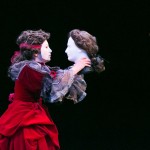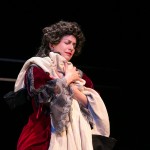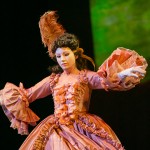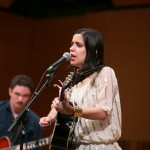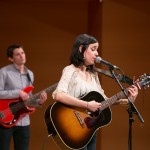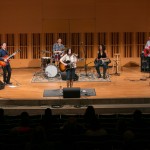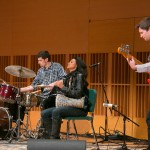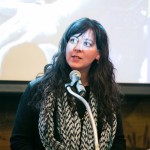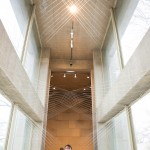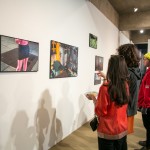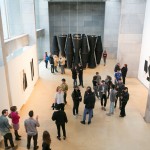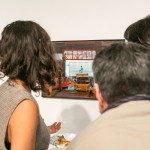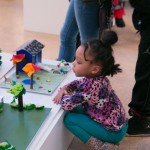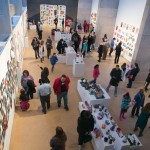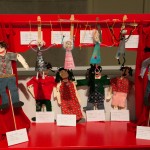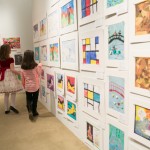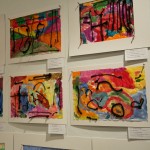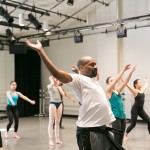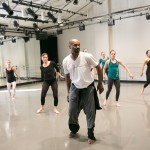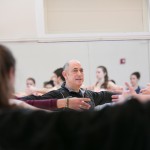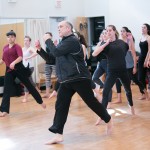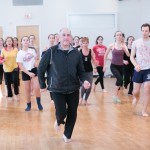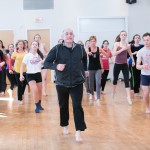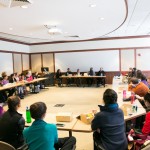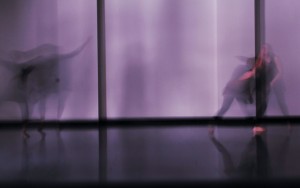CFA Arts Administration Intern Chloe Jones ’15 talks to stage manager Julia Tyminski ’17, and Albert Tholen ’15 and Grace Nix ’15, who are performing as Mr. and Mrs. Smith, in the Wesleyan University Theater Department production of Eugène Ionesco’s “The Bald Soprano,” which runs through Saturday, April 25, 2015 in the CFA Theater.

Standing (left to right): Edward Archibald ’17, Albert Tholen ’15. Photo by John Carr.
In 1950, Romanian playwright Eugène Ionesco wrote The Bald Soprano, one of the seminal plays of Theater of the Absurd. He was inspired by the cliché dialogues between the imaginary Mr. and Mrs. Smith in an English phrasebook for beginners. Albert Tholen ’15 and Grace Nix ’15 play Mr. and Mrs. Smith in the production by the Wesleyan University Theater Department, directed by Professor of Theater Yuri Kordonsky.
“We are a proper British couple with a twist,” says Ms. Nix with a sly smile.
The entire play takes place in the living room of Mr. and Mrs. Smith, in their home on the outskirts of London. “It’s a drawing room drama,” says Mr. Tholen. “One that goes horribly awry.”
With The Bald Soprano, Mr. Ionesco rejected coherent plot, character development, and the concept of realistic drama. Through dark and daring humor, the play discusses the futility of meaningful communication in contemporary society, and the tragedy of language in a universe driven by chance.
“It’s a very different logic of causality in this world,” says Ms. Nix. “An illogical logic.”
Ms. Nix and Mr. Tholen, along with the other four actors in the cast (Edward Archibald ’17, Sara Fayngolz ’17, Natalie May ’18, and Peter McCook ’16), have been working with Professor Kordonsky since the beginning of the semester. Together with dramaturge Rachel Sobelsohn ’17, assistant director May Treuhaft-Ali ’17, and stage manager Julia Tyminski ’17, they spent the first two weeks of rehearsal analyzing different translations of the play, originally written in French, to draft their own composite script.
“We spent hours talking about single words,” says Ms. Nix. “Until we arrived at a script, which we felt was the best expression of what this play is trying to say.”
“It’s nice to have ownership over the language in that way,” says Mr. Tholen. “It’s become our script.”
Professor Kordonsky gave the actors a great deal of creative responsibility throughout the process. They would divide into subsets and work on specific moments in the script, then come back together as a cast and share. They created scene after scene, gradually bringing both clarity and complexity to Mr. Ionesco’s absurdity.
“I think more than anything else, Mr. Smith is like a coat that I wear,” says Mr. Tholen. “I don’t get on stage and become him. It’s more of an attitude.”
“It’s the total acceptance of a different world,” says Ms. Nix. “Even though it doesn’t make any sense, it feels right.”
The Bald Soprano invites its audience to view the play from the actual stage of the CFA Theater, rather than from the house seats where one faces a proscenium.
“For this play you want an intimate connection with the audience,” says Ms. Nix. “If the audience were farther away, I think we would lose that connection and some of the urgency of the play.”
Sitting on the stage of the CFA Theater, the audience finds itself right there in the living room of Mr. and Mrs. Smith — in close proximity to the play’s simple set: a couch, some chairs, a clock.
“The set looks relatively realistic,” says stage manager Julia Tyminski ’17. “But the minute the show starts you realize it’s an absurd production, yet the actors are playing it as if it’s realism, and that’s where the comedy comes in.”
Wesleyan University’s Theater Department presents
The Bald Soprano by Eugène Ionesco
Wednesday, April 22 through Friday, April 24 at 8pm
Saturday, April 25 at 2pm and 8pm
CFA Theater
$8 general public; $5 senior citizens, Wesleyan faculty/staff/alumni, non-Wesleyan students; $4 Wesleyan students
Directed by Professor of Theater Yuri Kordonsky. Designed by Professor of Theater, Retired, Jack Carr (set and lights) and Artist in Residence Leslie Weinberg (costumes).



